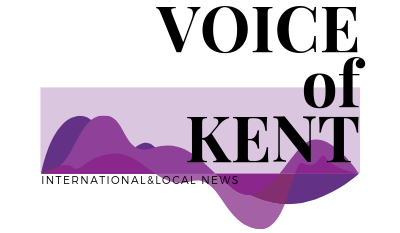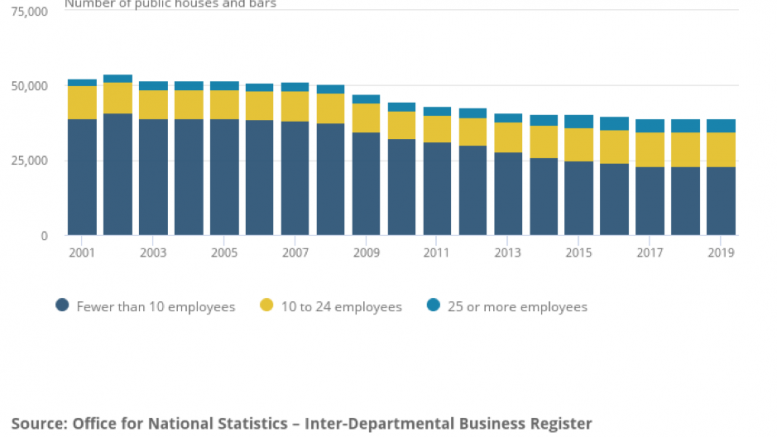The number of pubs and bars in the UK increased in 2019 for the first time in a decade, according to figures from the Office for National Statistics (ONS).
The industry had been on a long trajectory of decline between 2007 and 2018 but 2019 bucked that trend and saw growth of 0.8 per cent, rising by 315 establishments to 39,130.
The British Beer and Pub Association (BBPA) said it “cautiously welcomed the news.”
The ONS said this growth was driven by a rise in smaller pubs with 10 or fewer employees. “Small pubs and bars increased by 85 (a 0.4 per cent increase) in 2019. This follows more than 15 years of closures.”
Analysts agreed that we will have to wait to see if this marks a new trend that will last for years to come.
However, the data also revealed that every district in Kent has seen losses since 2001, with Medway the biggest loser, having lost 38 per cent of its pubs during the period, closely followed by Dover with -36 per cent and Tonbridge and Malling with -35 per cent.
The data also showed that during the same period, employment in pubs and bars and the number of pubs and bars had diverged, with employment rising and the total number of establishments falling, suggesting that there was growth in big pubs and that small pubs were the victims.
ONS data revealed last year that during the decade ending in March 2019, the average price of a pint had risen by 86p, representing more than a 30 per cent increase. The average cost of a pint in May 2009 was £2.81 and as of March 2019 it stood at £3.67.
In May 2018 a YouGov poll suggested the average price of pint was 60p more than Brits considered reasonable.
Nathaniel Reagon-Welsh, owner of The Ship Inn in Gilingham said it was “a tough business to be in,” but “worth it.”
He said that owning a pub isn’t any easier than it was when he started nine years ago and that ‘multi-sale’ deals in Tesco and Asda have hurt pubs like his. Because of this, “more young people chose to drink at home rather than pay extra to go to the pub.
“You need to give people something to come out for … events, playgrounds and nice food like a carvery dinner” were key to maintaining his pub as a “hub of the community.”
This is reflected by the ONS data which showed that more people are choosing to spend their money eating out, rather than drinking out.
Pubs and bars have employed more people serving food than bar-staff since 2015. Food service occupations now make up 43.8 per cent of jobs in the pubs and bars sector, compared to 28.9 per cent for bar-staff as of 2019.
He also looked to Scotland as a model to be emulated here, where the tax on alcohol per litre was raised, which made alcohol in supermarkets more expensive and reduced the discrepancy between them and pubs.
More importantly, he said, was for regulators to “clamp down on Tesco and Asda deals,” which make it tough for pubs across the country to stay competitive while remaining profitable.
“We’re only just surviving,” Nathaniel said, “the prices (at supermarkets) have hurt us” and the climbing costs of getting alcohol for the pub to sell make the slender profit margins even more attenuated.
Researchers at the Department of Epidemiology and Public Health at University College London conducted a study which found that the proportion of 16 to 24-year-olds who say they never drink alcohol rose from 18 per cent in 2005 to 29 per cent in 2015. The study also found that those who are drinking alcohol are drinking less than past generations.
The charity Alcohol Change UK also showed that overall consumption of alcohol has fallen by 16 per cent since 2004.
Analysts have also pointed to new technologies such as digital streaming services as a cause of the downturn in British pubs as people’s homes have been made more comfortable than they used to be so they have a greater incentive to remain at home.
Stuart Donaldson, senior campaigns manager at the Campaign for Real Ale (Camra) suggested that some of the issues pubs face are more straightforward; calling for a review of business rates and a tax system that is “fairer” to pubs.
“Pubs provide communities with many social and economic benefits. They are a big part of the cultural landscape of Britain.”
Business rates are the tax that businesses pay based on the value of their properties.
On 31 October 2019 the Treasury Select Committee called on the Treasury to review what it describes as a “broken Business Rates system.”
The committee reported that Business Rates have been steadily rising as a proportion of the total taxes that businesses pay since its introduction in 1990, even outpacing inflation.
The report also suggested these high taxes may be detrimental to investment in the UK.


Be the first to comment on "New figures show growth in UK pubs for first time in a decade"